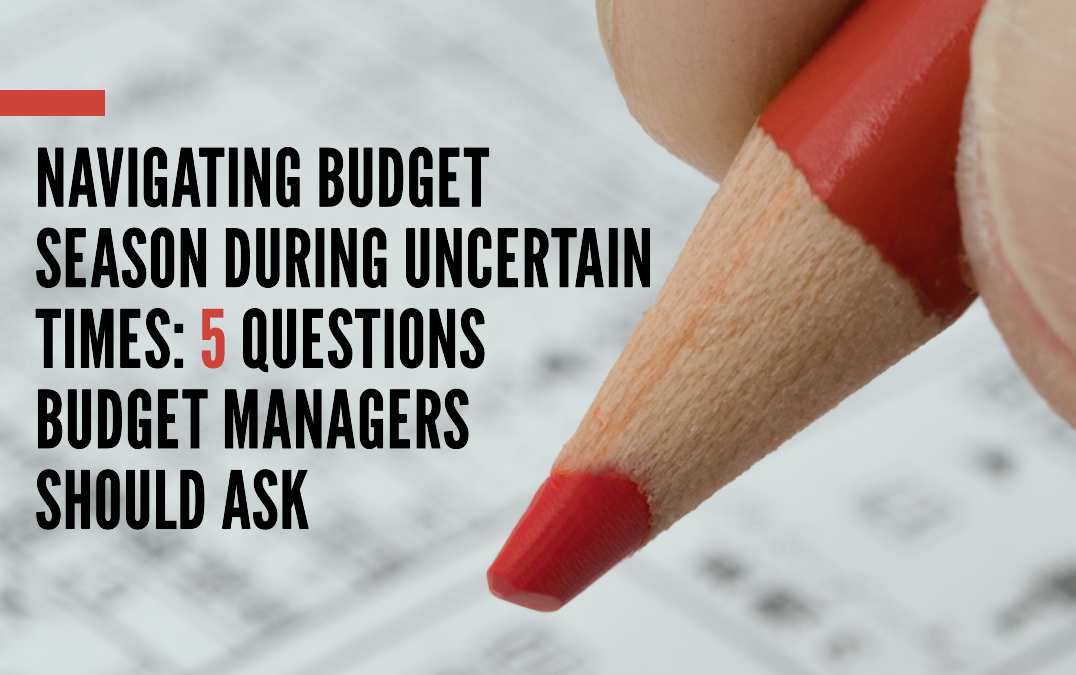
Emerging Leaders, Strategy Execution
It’s budget season for organizations on a calendar-based fiscal year. Whether you’re a seasoned professional or first-time budget manager, submitting a budget for approval during times of economic uncertainty can be a confidence shaker. Being a budget manager isn’t just about creating a wish list and bracing for a 30% cut. It’s about being a strategic thinker and a persuasive communicator. These five questions will help you win the hearts of senior leaders and get your budget approved, even when times are fiscally fickle.
1. What are the organization’s strategic goals? Before diving into the nitty-gritty of spreadsheets and numbers, take a step back and grasp the bigger picture. Understand the organization’s strategic goals and how your budget aligns with them. When you can clearly articulate how your financial plans contribute to the overall success of the company, you’ll earn the respect and support of senior leaders.
2. Who are the key decision makers? Knowing the lay of the land is crucial. Identify the key decision-makers in your organization, especially those with the final say on budget approvals. Take the time to understand their priorities and tailor your budget proposal to address their needs, where possible. Winning hearts can be just as important as crunching numbers.
3. What are the major cost drivers? As a budget manager, you’re not just a number cruncher. You’re also a detective. Dive into the data to identify the major cost drivers in your organization. Understanding where the money is going will help you make informed decisions and justify your budget allocations to senior leaders. It’s all about making your case with solid evidence.
4. Where can we save money? Let’s face it – everyone loves cost-saving superheroes. Channel your inner superhero and negotiate with vendors and suppliers for better pricing on products and services. This can result in significant savings over time and demonstrate your dedication to saving the organization’s resources.
5. What’s Plan B? Life is unpredictable, and budgets are no exception. Senior leaders appreciate budget managers who are prepared for unforeseen circumstances. So, create a Plan B – a contingency plan that outlines how you’ll handle unexpected challenges or changes in the financial landscape. Having a backup strategy shows your ability to think ahead and adapt to any situation.
By asking these five questions and incorporating the answers into your budget proposal, you’ll improve the odds of getting the resources you need and help your organization meet the challenges of the coming year.
Question: What are some of the budgeting tips in your management toolkit?

Emerging Leaders, Leadership
By: Sheri Nasim, President & CEO
I once worked for a CEO who challenged me to write my own job description. We’d been working together for a couple of years, and I’d met some pretty big goals that he’d set out for me. When I told my husband about the CEO’s invitation to write my own job description, my husband said,
“Why don’t you make it 25% about what you’re already comfortable with and 75% what you’ve never done before?”
After getting over my initial annoyance at my husband’s advice, I decided to go for it. I wrote a job description that would be my dream position at the company then shared it with the CEO. He thanked me for putting in the effort and asked for some time to think about it. A few days later, he handed my job description back to me across his desk. Not only had he accepted the role that I’d had asked for, but he added another significant amount of responsibility to it.
Quite honestly, it took a full year for me to completely understand what the new role meant in practice. But, the CEO patiently allowed me to grow into it and make it my own. A few years in, I’d fundamentally changed how the management team took responsibility both for strategy execution, budgeting, and accountability for meeting financial results. In the process, I watched our management team grow its collective business acumen and work cross-functionally to deliver results that exceeded our strategic goals. That was one of the greatest growth opportunities I’ve had in my career.
I share this story because this is the kind of imposter syndrome that I wish for my clients, my colleagues, and for you as readers of this message. I want to hear that you’ve been given so much responsibility – coupled with an equal amount of psychological safety – that you question whether you’re really up for the challenge. I want to hear that you’re excited to be part of something bigger than yourself and stretched beyond anything you’ve ever accomplished before. I want you to test your assumptions, double check your math, and have both a sense of excitement and fear.
If you’ve been given an opportunity to do something that’s significantly greater than anything else you’ve ever done before, don’t gaslight yourself into thinking that you don’t have the ability to deliver. Growth begins where your comfort zone ends.
Question: What percentage of your week are you really challenged?

Emerging Leaders, Leadership
According to a recent Zapier survey, 62% of Millennial workers have direct reports. What’s more, a Future Workplace study shows that not only are Millennials managing their Millennial and Gen-Z peers, they’re also managing Gen-X and Baby Boomer professionals. If you’re among the growing cohort of emerging leaders, chances are, you’re finding that your hard work does not automatically equate to a move up the proverbial leadership ladder.
The good news is that there are some overarching concepts that are key to leadership success that you can use to condition yourself as an emerging leader. Here are two practices that you can build into your leadership toolkit today that will not only serve you, but will benefit your team and your current and future employers for years to come.
1. Know yourself. Before you can effectively lead others, you need to spend time thinking about things like how you are wired, why you’re here, and what you bring to the table. In Leading at a Higher Level, Ken Blanchard suggests that leaders need to clarify their own leadership point of view (LPOV). Doing so will give your team the benefit of understanding where you are coming from, but they’ll also be clear on what you expect from them and what they can expect from you.
It takes time to develop your LPOV. But, doing so gives you the ability to do some self-archeology and anthropology. It allows you to connect the dots of where you come from and why you hold strong beliefs about certain things at work. Your LPOV will be better if you share your first draft with someone who knows you well and who you trust to give you honest feedback. You can find step-by-step instructions and sample LPOV’s in Leading at a Higher Level. Here’s a sample LPOV shared by Kirsten Hund, Leadership Program Director for The Holdsworth Center in Austin, Texas.
2. Develop enterprise thinking. When you land your first office job, chances are you get trained (formally or informally) on your role within the department and an assortment of technology tools to function within your role. If you get a promotion, you’ll gain exposure and access to a wider span of responsibilities. When you make the first order shift – from Role 1 to Higher Role 2 – you’ll get a better understanding of the dependencies that roles and departments have on one another, and your awareness of the annual organizational cadence increases. These are the seeds of enterprise thinking.
Enterprise thinking focuses on the way that the organization’s constituent parts interrelate and how the departments, processes, and operating systems work together. Five Ways to Develop an Enterprise Mindset offers an excellent example of how to make the seismic shift to grow as an enterprise thinker.
Knowing yourself (self-awareness) and developing enterprise thinking (others/systems awareness) are powerful counterparts that will serve you well as you move along the leadership continuum.
Question: What are some ways to take charge of building your leadership acumen?
Driven by the premise that excellence is the result of aligning people, purpose and performance, Center for Executive Excellence facilitates training in leading self, leading teams and leading organizations. To learn more, subscribe to receive CEE News!
![How 1 Simple New Year’s Resolution Will Help You Succeed]()
Emerging Leaders, Leadership, Purpose
In his book, When the Game Is Over, It All Goes Back in the Box, John Ortberg tells a story about his son. Ortberg says,
One day when my son was three, he had been working with a tape player for an hour or so. After a while he looked up at his mom and said, ‘Mom, you know what’s the trouble with life?’ His mom replied, ‘No I don’t. What’s the trouble with life?’ The three-year-old sitting on the floor, who had thoroughly reflected on both toy technology and the conditions of human existence, made a profound observation. ‘The trouble with life is that it doesn’t have a rewind button!’ Every day and every minute carries its own finality. Time is a non-renewable resource.”
(more…)



